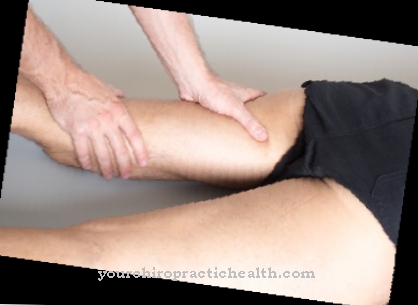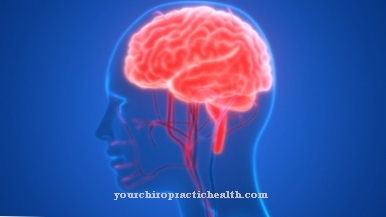As Mirror movement Medicine describes the representation of passively observed actions in the brain of primates. This neural representation takes place via the mirror neurons. The mirror system probably plays a role in the context of imitation and empathy.
What are mirror movements?

Mirror neurons are nerve cells in the brain. They are activated when a process is passively viewed and show the same activity patterns as if the viewer were performing the observed activity themselves. In addition to action-related noises, mirror neurons also show the same activity for observed motor skills that they would show if the observed action were actually carried out.
Since its first description in 1992, medicine has assumed a mirror neuronal involvement in behavioral patterns of imitation and compassion. The mirror system corresponds to the Brodmann Areal 44 and was discovered by the Italian Giacomo Rizzolatti. The recognition of actions and the imitation seem to be directly related to the area.
The existence of mirror neurons has now been confirmed in humans, but what the neurons are used for has not yet been comprehensively clarified. In addition to mirror neurons, humans have anti-mirror neurons, the activity patterns of which differ when observing and performing an action. In 2008, researchers observed brain activity in the mirror system, which provides compelling evidence for the involvement of the motor and somatosensory cortex and the related activation of the mirror system. This proof is also known as mirror movement. Mirror movements are therefore the playing through of passively observed movements within one's own mirror system.
Function & task
Man has the ability to imitate the intentions of others and to understand them through mere observation. Research groups coordinated the 'Mirror' research project in the 2000s and examined the organization of the mirror system, which shows a strong involvement in human cognitive functions. The research group examined the role of the motor cortex in imitated and passively observed actions. The involvement of the brain region was clarified by the 14C-deoxyglucose method, which enabled a pictorial representation of all brain activities. The method is based on the fact that the relative speed of consumed glucose and energetic metabolism reflects, at least to some extent, the functional activity of the brain regions.
The involvement of the mirror system in observed actions was observed much earlier for monkeys. The monkeys watched the human grasp an object or carried out the activity themselves. Both during the imitation and during the observation there was activation of the corresponding areas in the motor and primarily somatosensory cortex. Both regions are included in the mirror system. So monkeys showed similar neurological activity patterns when observing and performing an action. The evidence for a representation of observed actions in the motor cortex in monkeys was therefore considered to be certain.
The research group of the Mirror project assumed that movement details would be stored in the form of neurological representation within the mirror system. The mirror movement seems to let monkeys at least understand the intentions of an observed movement better. The primate mirror neurons are already active immediately before the movement is actually perceived. The brain thus apparently creates a rough idea of the events to be expected and stimulates the associated regions. In this way, the human brain presumably also provides a prediction of the unexpected and the future.
The motor simulation applies not only to the observation of other people, but also to the observation of moving points or machines. In addition to mirror movements when observing body movements, there are probably also those for observing emotional movements. Today researchers are at least speculating about the relevance of the mirror system for passively observed emotional movements and empathy. The existence of emotion mirror neurons has not yet been proven, but a connection between motor mirror neurons and empathy is being discussed as a possibility.
You can find your medication here
➔ Medicines to improve concentration and language skillsIllnesses & ailments
Illnesses and complaints of the mirror system are not yet known, as research on this is still in its infancy. Presumably, different neurological symptoms can also affect the mirror neurons. For example, inflammation of mirror neuronal nerve tissue, as occurs in the context of the autoimmune disease multiple sclerosis, is conceivable. Likewise conceivable connections for mirror neuronal lesions are tumors in Brodmann area 44 or strokes.
Whether symptoms with imitation or empathy arise after mirror neuronal lesions remains the subject of research. Research into the mirror system and the movement of mirrors in humans has so far only been possible in exceptional cases. Most of the research was carried out in the context of operations on the brain and otherwise untreatable epilepsy. In the case of epilepsy, deep electrodes were transplanted into the corresponding regions in order to precisely localize the foci. After the patient's consent, the electrodes were used for additional scientific measurements and in this way contributed to the findings in the mirror movement.
Nonetheless, no neurons were examined in humans in the areas that are known to be mirror neuron areas in macaques, since epilepsy foci are rarely found in these areas. Measurements in other areas were useful in order to measure the local distribution of the mirror neurons, which in humans does not necessarily correspond to the areas common among macaques. At least a small number of mirror neurons could be detected this way.
However, since the study participants were exclusively patients with a neurological disease, universal relationships remain controversial. Critics also claim that mirror neurons cannot play a perpetrator role in understanding action because they are not intelligent agents. Complex things like the intentions of other people depend on representation in at least as complex networks.













.jpg)

.jpg)
.jpg)











.jpg)